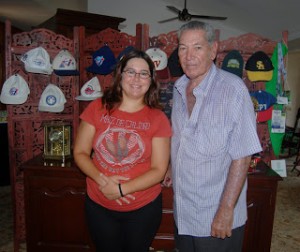Pasante InteRDom Otoño 2011
La Experiencia InteRDom, artículo # 1
Christine Martínez estudia Estudios Globales con estudios menores en el periodismo y español en la San Jose State University en San José, California. Ella está participando en el programa semestre académico del otoño de2011, y está tomando cursos en una universidad local mientras lleva a cabo un proyecto de investigación especialmente estructurado para ella por el personal de InteRDom acerca del negocio de béisbol en la República Dominicana.Los artículos que seproduce será publicado en este blog bajo la etiqueta «InteRDom Experience Series.» Para leermás sobre la experiencia de Chris con InteRDom en la República Dominicana, leala serie La Experiencia InteRDom en la página web de InteRDom.
Para entender el béisbol en la República Dominicana, lo mejor es consultar al mejor hombre para ese trabajo. Epifanio Guerrero ha contratado a más jugadores para las Grandes Ligas que cualquier otro cazador de talentos, ha producido talentos que han ganado la Serie Mundial, y ha ganado un montón de premios por sus logros. En la actualidad continúa su trabajo como cazador de talentos independiente en la República Dominicana.En estos días, Epy es un tipo afable que está ansioso por contar historias sobre sus 40 años en el béisbol. Su casa, en su complejo de entrenamiento en Villa Mella, tiene un cuarto lleno de fotos de sus jugadores, artículos sobre su obra, y premios por sus logros.
El éxito de Guerrero en el deporte se puede resumir en una foto enmarcada que se encuentra en su casa de Santo Domingo. Es de los tres miembros más nuevos del Salón y Museo de la Fama en Cooperstown, Nueva York: el lanzador derecho Bert Blyleven, el jugador de cuadro Roberto Alomar, y el ejecutivo Pat Gillick. El trío fue admitido en el Salón de la Fama este mes de julio, y Guerrero estuvo disponible para celebrar junto con Alomar y Gillick, dos hombres que le deben mucho de su éxito a Guerrero.
Guerrero trabajó como cazador de talentos en la organización de los Azulejos de Toronto, firmando y desarrollando a jugadores como Carlos Delgado, Tony Fernández, y Dámaso García. En 1991, catorce jugadores de la lista de 40 jugadores de Toronto eran chicos que Guerrero firmó y desarrolló. Al año siguiente, los Azulejos de la Dominican Summer League ganaron 38 partidos al comenzar la temporada 1992 antes de terminar 68-2.
Objetos de los dos hitos se encuentran también en casa de Guerrero en Santo Domingo. Hay una foto, amarillenta debido al paso del tiempo y que cuelga en la pared, de Guerrero de pie con siete de sus hijos en 1991. Una gorra de béisbol blanca bordada con el logo de los Azulejos y con una inscripción especial del record de 38-0 del equipo de la DSL cuelga de su escritorio.
Por supuesto, es el gran premio de la organización de los Azulejos. Toronto ganó dos títulos consecutivos de la Serie Mundial en 1992 y 1993, gracias en gran parte a la reserva de talentos de Guerrero. Alomar fue una de las estrellas ofensivas de esos equipos.
Gillick era el gerente general de los Azulejos cuando ganaron sus títulos mundiales y pasó a ganar otra Serie Mundial con el equipo de Filadelfia en el 2008 antes de retirarse del trabajo ejecutivo.Guerrero formó los equipos de Toronto para Gillick, alguien con quien todavía se mantiene cercano y a quien se refiere como a una figura paterna.
Guerrero también ha cazado talentos para Houston y Milwaukee, pero ha visto llegar los mayores logros de su carrera en Toronto. Ahora trabaja para sí mismo, desarrollando a niños dominicanos independientemente de cualquier equipo.
El legado de Guerrero en la República Dominicana se puede ver en el talento que envía a las Grandes Ligas, así como también en su organización más importante: su familia.
Está claro que Guerrero valora a la familia en el béisbol. Sus hijos, Sandy, Patrick, y Mike trabajan todos en el deporte. Sandy es el entrenador de bateo para Triple-A Nashville Sounds en la organización de los Cerveceros, y Mike fue gerente de Double-A Huntsville, equipo también afiliado a los Cerveceros, en el 2009. Patrick trabaja con su padre en el campo de entrenamiento de Villa Mella.

